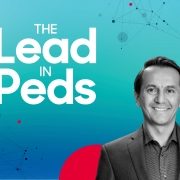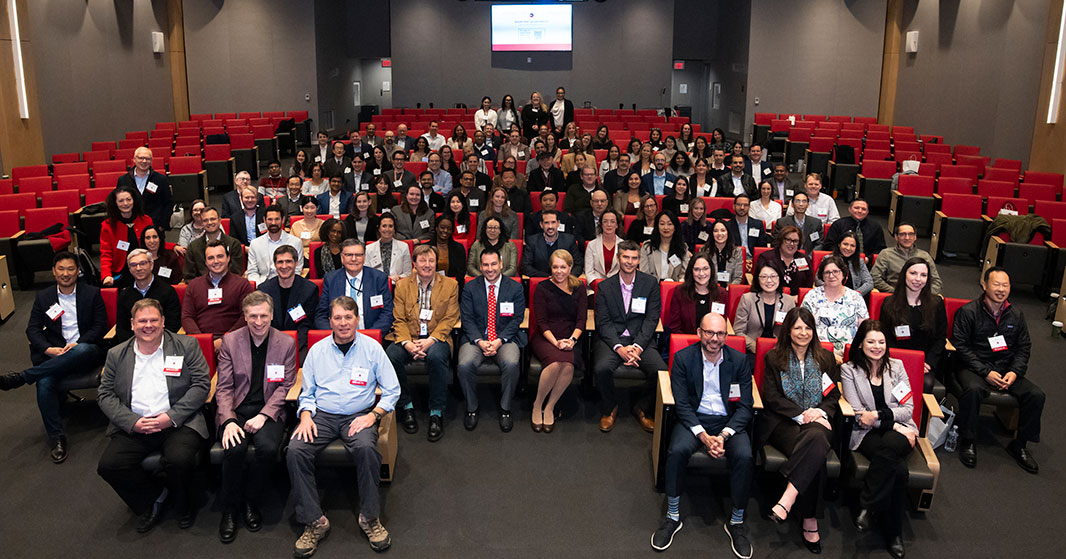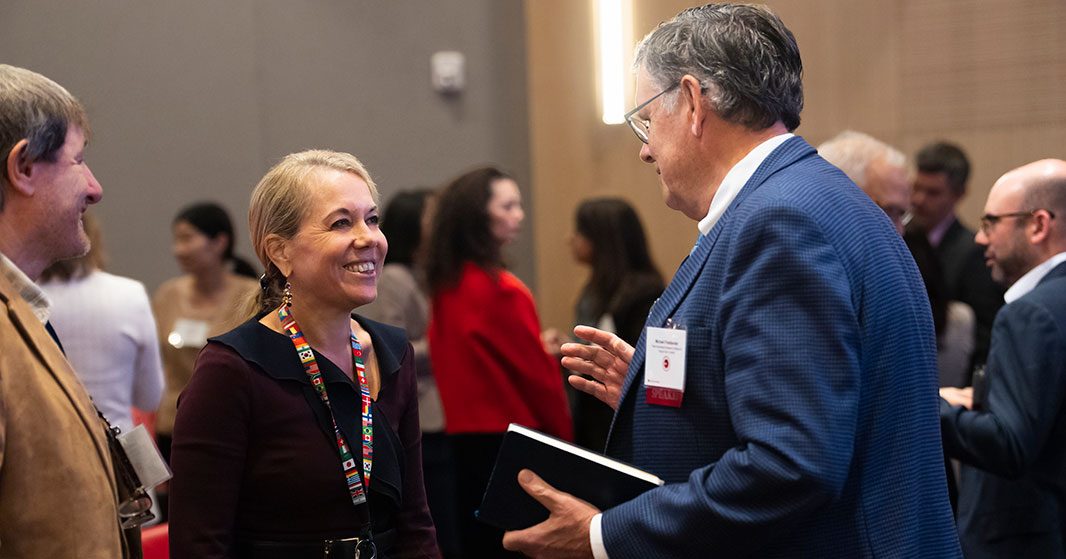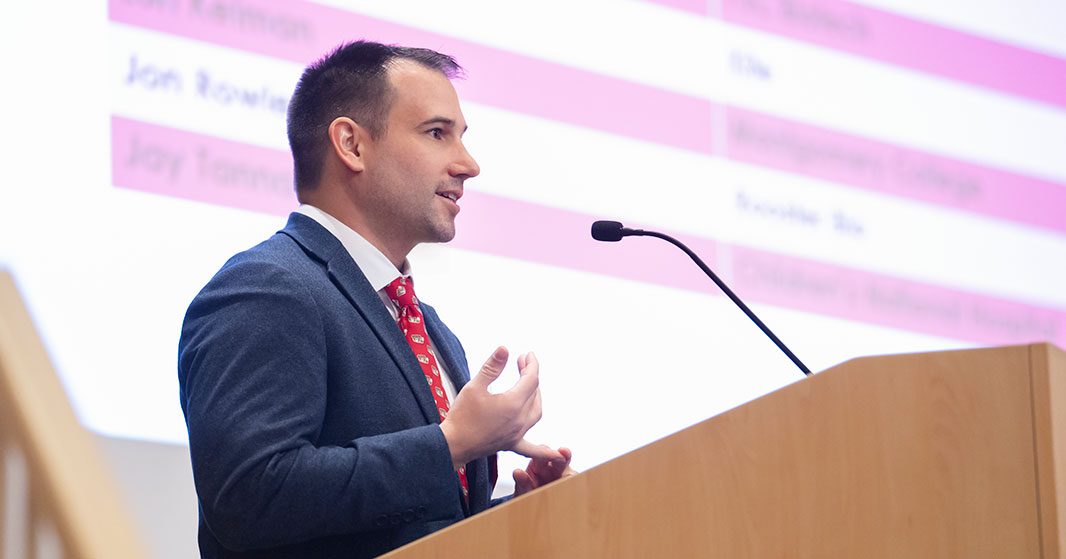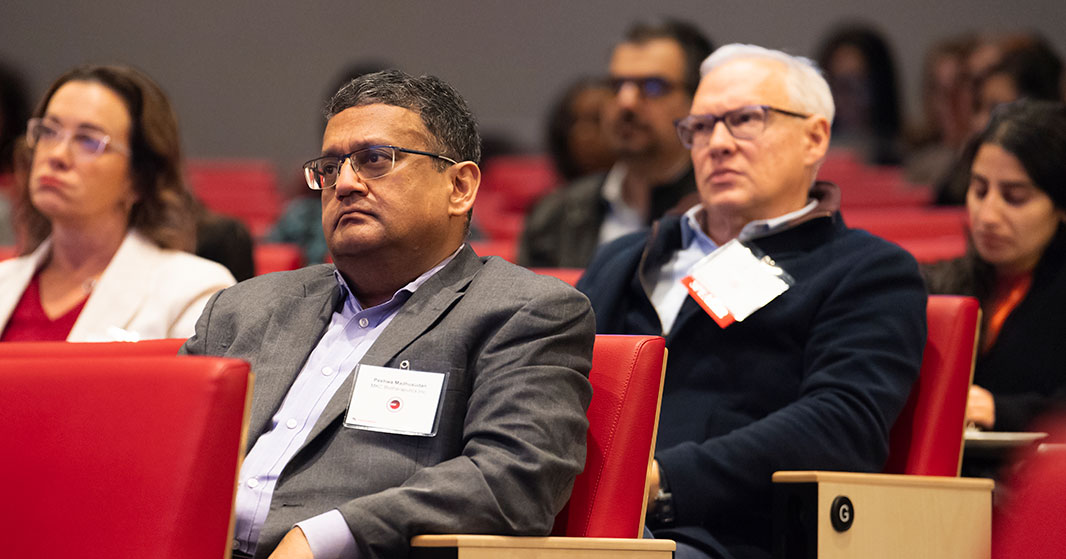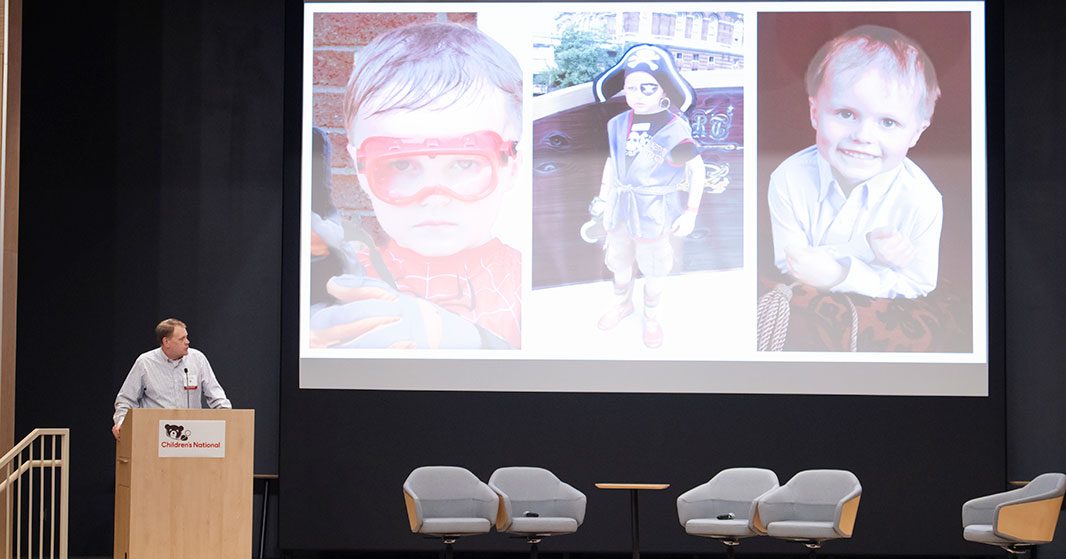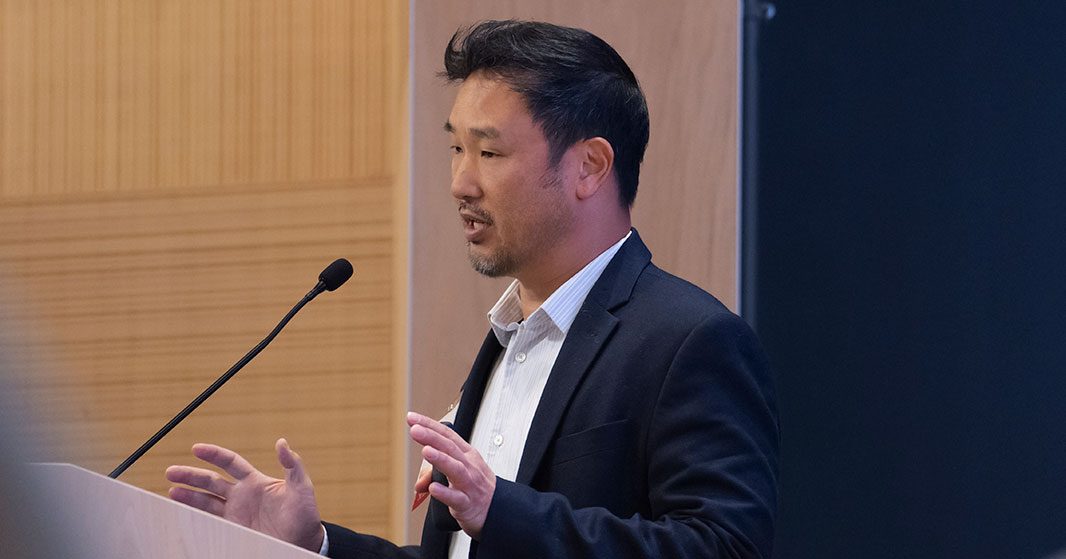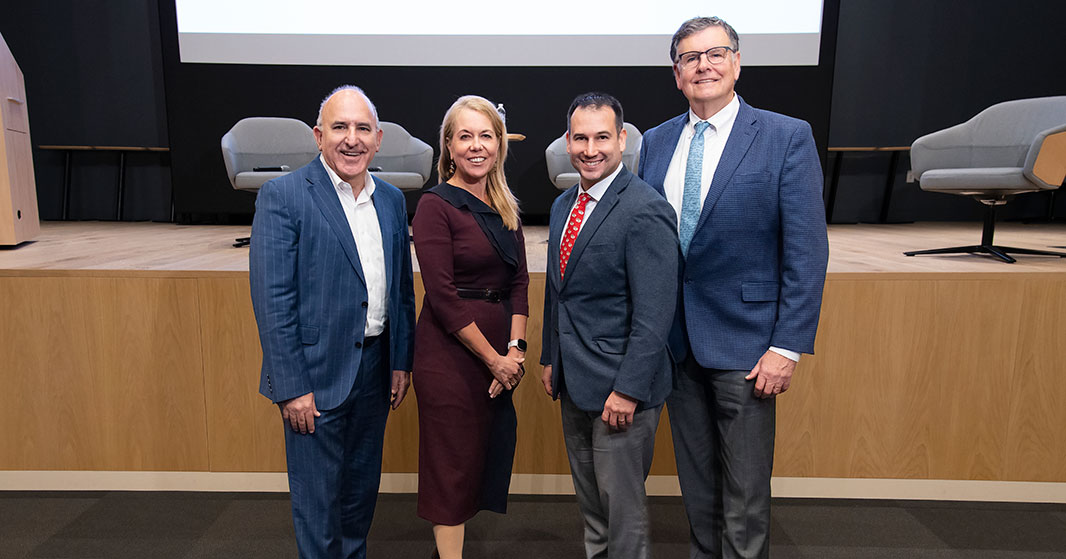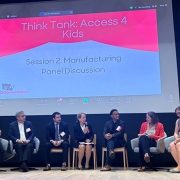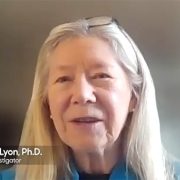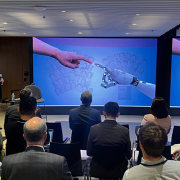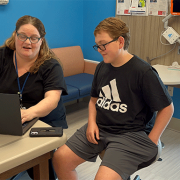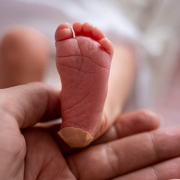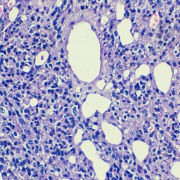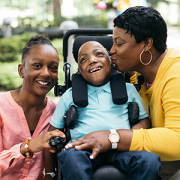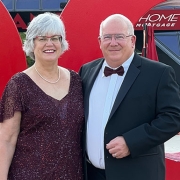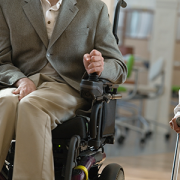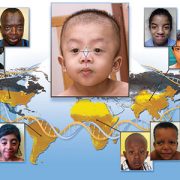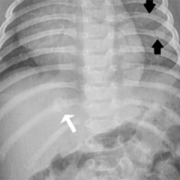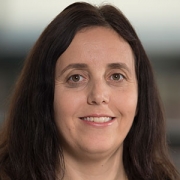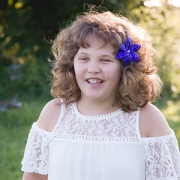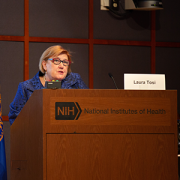Tag Archive for: rare disease
Genomics solves puzzles for patients with rare disease
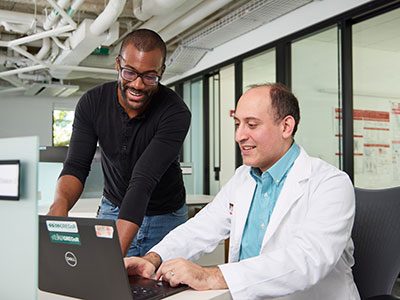
Dr. Seth Berger (right) and pediatric resident Dr. Kirkland Wilson.
Most patients with rare diseases still lack answers. Families may undergo years of searching in an often painful diagnostic odyssey.
Research by Seth Berger, M.D., Ph.D., a medical geneticist in our Center for Genetic Medicine Research and Rare Disease Institute, aims to harness technologies to shorten this journey and connect families with help sooner. Dr. Berger often publishes accounts of medical mysteries he has solved.
“It’s truly stunning what genetic sequencing can find. The outcomes can be life-changing. These cases with life-altering diagnoses don’t come along every day, but when they do, they make the hunt to find answers all the more worthwhile,” says Dr. Berger.
James finds a path to health
James, age 15, struggled a lot before a researcher at Children’s National found the needle in the haystack of his genome. Four years ago, he could not walk in a straight line down the sidewalk. Enjoying Halloween trick or treating in fall or a beach hike in summer? Out of the question. His gait had become increasingly unsteady.
Everything changed the day that Dr. Berger took a look at James’ exome — a subset of the genome that can reveal mutations — to help his family find answers. Dr. Berger used advanced biochemical testing, genomic sequencing and AI to sift through the patient’s data. He found the problem: dopa-responsive dystonia, a genetic condition seen in only one out of every 1 million children. In fact, James’ case was even rarer because he had an unusual recessive form.

James (left) rides mountain bikes with his brother, Nicholas, and mom, Shannon.
This discovery led to a cascade of positive events that transformed James’ life for the better. Thankfully, his condition has a known treatment. Laura Tochen, M.D., who directs the hospital’s Movement Disorders Program, started James on carbidopa-levodopa, a drug combination used to treat Parkinson’s disease and other neurological disorders. Within two hours, he showed improvement and his gait was almost normal.
Today, James leads an active life. On vacation last summer, he went rock climbing on real rocks for the first time. He loves mountain biking and running along the Maine coast. “He is very proud of what he can do now,” says his father, Jeff. “We are so thankful for the team that helped get him here.”
Read more stories like this one in the latest issue of Believe magazine.
Regional powerhouse: Cell and Gene therapy leaders from mid-Atlantic forge connections
Nearly 200 biomedical leaders from Washington, D.C., Maryland, and Virginia gathered at the Children’s National Research & Innovation Campus for the 2nd annual Cell & Gene Therapy Symposium. The event showcased groundbreaking developments in rare disease treatments and underscored the importance of regional collaboration.
“By targeting diseases at the cellular level, we are on the cusp of breakthroughs in cell and gene therapy that will transform medicine,” said Catherine Bollard, M.D., M.B.Ch.B., director of the Center for Cancer and Immunology Research (CCIR) at Children’s National Hospital and a host of the symposium. “Progress will accelerate if we build partnerships beyond our own organizations.”
The big picture
Scientists and clinicians have worked for more than two decades to develop cell and gene therapies aimed at treating diseases on a cellular level. The past few years have been particularly promising as investment in science has led to advancements. Children’s National is at the forefront, as one of the first pediatric hospitals in the world to offer commercial gene therapies for sickle cell disease.
Many more treatments for rare diseases are in development at Children’s National and beyond. Leaders at CCIR are actively building collaborations with companies, academic institutions and enterprises across the mid-Atlantic region to accelerate these efforts.
During the symposium, Eugene Hwang, M.D., chief of Oncology at Children’s National, addressed the urgent need for more effective and less toxic treatments for pediatric brain tumors. He highlighted the potential of combining immunotherapies with innovations like low-intensity focused ultrasound, which can open the blood-brain barrier temporarily to improve drug delivery to tumors.
“With collaboration between the lab and clinic, alongside industry partners and even between hospitals, we can finally make strides I haven’t seen in my entire career,” Dr. Hwang said. “It’s an incredibly inspiring time for all of us.”
Why it matters
Experts from organizations as diverse as MaxCyte, ScaleReady, RoosterBio, PSC Biotech, Qiagen, FujiFilm and the Frederick County Office of Economic Development came together for the daylong conversation.
Michael Friedlander, Ph.D., executive director of the Fralin Biomedical Research Institute at Virginia Tech, emphasized the critical role of regional partnerships in fulfilling the potential of these emerging therapies. He pointed to the collaborative research between Children’s National and Virginia Tech on brain tumors, where bioengineers and cancer researchers are working side-by-side to create new treatments.
“We are now able to begin delivering these leading-edge therapies to patients,” Dr. Friedlander said. “For example, those who live in rural settings often have much less access to such frontline medical innovations. By collaborating with Children’s National and gaining access to urban pediatric populations, as well as patients in our more rural area, we can start to bring these therapies to a much broader audience.”
What’s next
Patrick Hanley, Ph.D., chief and director of the Cellular Therapy Program at Children’s National, observed that other regions in the U.S. are uniting to advance scientific discoveries with the backing of government, academia and industry. He hopes to see similar collaboration across the D.C., Maryland, and Virginia area, known as the DMV. Children’s National is leading an initiative called CHARM – the Capital Health and Mid-Atlantic Regenerative Medicine – to bring regional experts together for webinars, networking events and partnership opportunities.
“There’s significant interest in cell and gene therapy worldwide,” said Dr. Hanley, a symposium host. “I see an even greater interest in creating cell and gene therapy hubs. The time is right for our mid-Atlantic region, and I’m excited to see what unfolds in the next five years.”
Access4Kids: A new model to pay for pediatric cell and gene therapies
Science is pioneering cures for pediatric rare diseases in a coming wave of new cell and gene therapies. However, the biopharmaceutical industry’s insistence on large patient populations and high profit margins may prevent these life-saving treatments from reaching the children who desperately need them. When successful therapeutics fail to see commercialization, experts say they have fallen into the “Valley of Death.”
To address this, leaders from pediatric healthcare, federal organizations, academia, industry and patient advocacy groups gathered at the Children’s National Research & Innovation Campus. Their objective: build a new framework to deliver these transformative drugs to clinics worldwide.
Meet the team forming Access4Kids, a nonprofit whose mission is to build new pathways to pay for cures and provide hope to children with life-limiting diseases. This group is working to change medicine and how we pay for it, under the leadership of Catherine Bollard, M.D., M.B.Ch.B., director of the Children’s National Center for Cancer and Immunology Research, Crystal Mackall, M.D., director of the Stanford Center for Cancer Cell Therapy, Julie Park, M.D., Oncology Department chair at St. Jude Children’s Research Hospital, and Alan Wayne, M.D., pediatrician-in-chief at Children’s Hospital Los Angeles.
Pilot program improves well-being of families during advanced care planning
Children with life-limiting rare diseases and their caregivers face tremendous stress and anxiety about the heart-breaking decisions before them. A new intervention – designed at Children’s National Hospital to support the palliative needs of these families – improved their spiritual and emotional well-being, according to new research published in the journal, Pediatrics.
Called FACE Rare (FAmily CEntered Pediatric Advance Care Planning Intervention for Rare Diseases), the counseling tools were found to be safe, effective and increased feelings of peace among families in this underserved population.
“Seventy-four percent of the families in that intervention group reported feelings of sadness, yet 100% reported our pilot intervention was a worthwhile experience,” said Maureen Lyon, Ph.D., a clinical psychologist and principal investigator at the Center for Translational Research at Children’s National. “If you’re talking about the possibility that the worst thing in the world would happen to you – that your child might die, and what you would want for them – the families found that our intervention helped. They had a place to process their feelings and consider what would be important to their child.”
The big picture
A rare disease is defined as any condition affecting fewer than 200,000 people in the United States. In pediatrics, these diseases often require constant caregiving and require families to face the cruel reality that the diagnosis may be life-limiting. In such cases, clinical teams often decide that conversations about advanced care planning (ACP) are needed.
The pilot-phase, randomized trial enrolled patients from Children’s National between 2021 and 2023. Research nurses underwent two days of training to be certified in the new intervention. Families assigned to the new approach received three, weekly 60-minute sessions and were evaluated using evidence-based assessment tools, including the Carer Support Needs Assessment Tool/Action Plan and the Next Steps: Respecting Choices Pediatric ACP Conversation. Measures of anxiety and spiritualization were tracked, and families returned after three months for follow-up.
Patients had a range of diagnoses that put tremendous strain on the caregivers, including complex digestive disorders, white-matter diseases and rare forms of epilepsy. Yet the caregivers expressed similar challenges: having time for themselves during the day, knowing what to expect in the future for their child’s care, and managing financial, legal and work issues.
What we found
Reinforcing the need to improve engagement and support for these families, the investigative team found that those who received the FACE Rare intervention reported higher levels of spiritual meaning and peace than those who received “treatment as usual.” All families living below the poverty line reported greater anxiety, and noteworthy to the team, black caregivers were less likely to report caregiver distress than non-black caregivers.
Dr. Lyon said future research needs to understand better how families respond to the challenges of rare diseases and unique social determinants of health that can change the approach to care.
“In some cultures, and families, having strong feelings is discouraged,” Dr. Lyon said. “We want to give families and caregivers space to have these emotions and think about what would be important for their child, if the worst were to happen. They appreciated that they participated in the program and had the space to consider these difficult questions.”
Read the full study, “Advance Care Planning for Children with Rare Diseases: A Pilot RCT,” in Pediatrics.
Artificial – and accelerated – intelligence: endless applications to expand health equity
In the complex world of pediatric diseases, researchers need access to data to develop clinical trials and the participation of vulnerable patients to develop new devices and therapies. Both are in short supply, given that most children are born healthy, and most severe pediatric diseases are rare.
That creates a dilemma: how do researchers build a foundation to advance new treatments? Enter artificial intelligence (AI).
“AI is the equalizer: accelerated intelligence for sick kids. No other advance on the horizon holds more promise for improving equity and access to pediatric healthcare when diseases are rare and resources are limited,” says Marius George Linguraru, D.Phil., M.A., M.Sc., the Connor Family Professor in Research and Innovation and principal investigator in the Sheikh Zayed Institute for Pediatric Surgical Innovation (SZI). “AI will shrink the distance between patient and provider, allowing our physicians and scientists to provide targeted healthcare for children more efficiently. The possibilities are endless.”
Why we’re excited
By pioneering AI innovation programs at Children’s National Hospital, Dr. Linguraru and the AI experts he leads are ensuring patients and families benefit from a coming wave of technological advances. The team is teaching AI to interpret complex data that could otherwise overwhelm clinicians. Their work will create systems to identify at-risk patients, forecast disease and treatment patterns, and support complex clinical decisions to optimize patient care and hospital resources. Already, the AI team at SZI has developed data-driven tools touching nearly every corner of the hospital:
- AI for rheumatic heart disease (RHD): In partnership with Children’s National cardiology leaders, including Craig Sable, M.D., the Uganda Heart Institute and Cincinnati Children’s Hospital, the AI team has developed an algorithm that can use low-cost, portable ultrasound imaging to detect RHD in children and young adults, a disease that takes nearly 400,000 lives annually in limited-resource countries. Early testing shows the AI platform has the same accuracy as a cardiologist in detecting RHD, paving the way for earlier treatment with life-saving antibiotics. This year, Children’s National physicians will be in Uganda, screening 200,000 children with local cardiology experts and AI technology.
- Newborn screening for genetic conditions with mGene: Working with Rare Disease Institute clinicians and Chief of Genetics and Metabolism Debra Regier, M.D., the AI team has built technology to detect rare genetic disorders, using an algorithm and a smartphone camera to identify subtle changes in facial features. Tested on patients from over 30 countries and published in The Lancet Digital Health, the application helps screen children for advanced care when a geneticist may not be within reach. With funding from the National Institutes of Health, Children’s National and its research partners are piloting a newborn screening program in the Democratic Republic of the Congo.
- Pediatric brain tumors: To improve and personalize the treatment decisions for children with brain tumors, Dr. Linguraru’s team is working with Brain Tumor Institute Director Roger Packer, M.D., the Gilbert Family Distinguished Professor of Neurofibromatosis, on algorithms that can characterize and measure brain tumors with unprecedented precision. The team recently won the International Pediatric Brain Tumor Segmentation Challenge, distinguishing the Children’s National algorithm as among the best in the world.
- Ultra-low field magnetic resonance imaging (MRI): With a grant from the Bill & Melinda Gates Foundation, the AI team is working alongside Children’s Hospital Los Angeles, King’s College London and the UNITY Consortium to expand global brain imaging capacity. The consortium is helping clinicians in limited-resource countries improve the treatment of neonatal neurological conditions, using AI to boost the quality of ultra-low field MRI and expand access to this portable and more affordable imaging option.
- Federated learning: Children’s National has collaborated with NVIDIA and other industry leaders to accelerate AI advances through federated learning. Under this approach, institutions share AI models rather than data, allowing them to collaborate without exposing patient information or being constrained by essential data-sharing restrictions. The SZI team was the only pediatric partner invited to join the largest federated learning project of its kind, studying the lungs of COVID-19 patients. Details were published in Nature Medicine.
Children’s National leads the way
Looking ahead, the Children’s National AI team is pursuing a wide range of advances in clinical care. To support patients treated at multiple clinics, they are developing systems to harmonize images from different scanners and protocols, such as MRI machines made by different manufacturers. Similar work is underway to analyze pathology samples from different institutions consistently.
Automation is also making care more efficient. For example, using data from 1 million chest X-rays, the team is collaborating with NVIDIA to develop a conversational digital assistant that will allow physicians to think through 14 possible diagnoses.
Dr. Linguraru says he and his colleagues are galvanized by the jarring statistic that one in three children with a rare disease dies before age 5. While well-implemented AI initiatives can change outcomes, he says the work must be done thoughtfully.
“In the future, patients will be evaluated by human clinicians and machines with extraordinary powers to diagnose illness and determine treatments,” Dr. Linguraru said. “Our team at Children’s National is leading conversations about the future of pediatric healthcare with a focus on safety, resource allocation and basic equity.”
Learn more about our AI initiatives
Innovation leaders at Children’s National Hospital are building a community of AI caregivers through educational and community-building events. At the inaugural Symposium on Artificial Intelligence in 2023 at the Children’s National Research & Innovation Campus, experts from Virginia Tech, JLABS, Food and Drug Administration, Pfizer, Oracle Health, NVIDIA, AWS Health and elsewhere laid out a vision for using data to advance pediatric medicine. The symposium will return on Sept. 6.
Dr. Linguraru is the program chair of MICCAI 2024, the top international meeting on medical image computing and computer-assisted intervention and the preeminent forum for disseminating AI developments in healthcare. The conference is an educational platform for scientists and clinicians dedicated to AI in medical imaging, with a focus on global health equity. It will take place for the first time in Africa on Oct. 6-10.
M.D. in your pocket: New platform allows rare disease patients to carry medical advice everywhere
When someone has a rare disease, a trip to the emergency room can be a daunting experience: Patients and their caregivers must share the particulars of their illness or injury, with the added burden of downloading a non-specialist on the details of a rare diagnosis that may change treatment decisions.
Innovators at Children’s National Hospital and Vanderbilt University Medical Center, supported by Takeda, are trying to simplify that experience using a new web-based platform called the Rare Disease Clinical Activity Protocols, or Rare-CAP. This revolutionary collection of medical information allows patients to carry the latest research-based guidance about their rare disorders in their phones, providing a simple QR code that can open a trove of considerations for any medical provider to evaluate as they work through treatment options for someone with an underlying rare disease.
“No one should worry about what happens when they need medical help, especially patients with rare diseases,” said Debra Regier, M.D., division chief of Genetics and Metabolism at Children’s National and Rare-CAP’s lead medical advisor. “We built this new tool because I have watched as my patient-families have wound up in an emergency room — after all, kids get sprains or fractures — but they don’t have the expertise of a rare disease specialist with them. My hope is that they’re going to pull out their phones and access Rare-CAP, which will explain their rare disease to a new provider who can provide more thoughtful and meaningful care.”
The big picture
A rare disease is defined as any disorder that affects less than 200,000 people in the United States. Some 30 million Americans are believed to be living with one of the 7,000 known rare disorders tracked by the National Organization of Rare Diseases (NORD). Led by Dr. Regier, the Rare Disease Institute at Children’s National is one of 40 NORD centers for excellence in the country that provide care, guidance and leadership for the wide array of disorders that make up the rare disease community.
While a key goal of Rare-CAP is to bolster patient self-advocacy, the platform will also allow medical providers to proactively search for protocols on rare diseases when they know they need specialized advice from experts at Children’s National, a network of tertiary care centers and patient organizations.
As a leading values-based, R&D-driven biopharmaceutical company, Takeda has committed $3.85 million to the project to help activate meaningful change and empower a brighter future for rare disease communities, providing a unique understanding of the struggle that patients and caregivers face when they need care.
“Our team, alongside the medical and rare disease community, saw the need for a single portal to collect standardized care protocols, and we are thrilled to see this innovative tool come to life,” said Tom Koutsavlis, M.D., head of U.S. Medical Affairs at Takeda. “People with rare diseases and their caregivers need faster access to authoritative medical information that providers anywhere can act on, this will lead to improving the standard of care, accelerating time to diagnosis and breaking down barriers to increase equitable access.”
The patient benefit
The creators of Rare-CAP imagined its use in a wide range of settings, including emergency rooms, surgical suites, dental offices, urgent care offices and school clinics. The platform will eventually profile thousands of rare diseases and lay out the implications for care, while also creating a dynamic conversation among users who can offer updates based on real-world experience and changes in medical guidance.
“Our patients are unique, and so is this tool,” Dr. Regier said. “As we roll out Rare-CAP, we believe it is just the beginning of the conversation to expand the platform and see its power for the patient and provider grow, with each entry and each new rare disease that’s added to the conversation.”
JAMA Pediatrics editorial: A better approach for newborn screening
The medical community has an opportunity to update its approach to newborn screening (NBS) to be prepared for emerging technological advancements that will help diagnose children with rare diseases from their first weeks of life, according to an editorial from a leading Children’s National Hospital researcher published in JAMA Pediatrics.
“In health care, we are seeing ways in which we can identify more children who have rare diseases even earlier, in the newborn period, rather than waiting for children to develop symptoms or experience irreversible changes,” said Beth Tarini, M.D., M.S., M.B.A., associate director of the Center for Translational Research. “We have continued innovations in screening technology – with more on the way – that can be added to the screening programs overseen by all 50 states. Updating how we approach newborn screening presents an incredible opportunity for doctors and their patient-families.”
Why it matters
Newborn screening happens before the baby leaves the hospital, generally with a prick of the heel to take a small sample of blood to look for several dozen rare, debilitating disorders such as sickle cell disease, congenital hypothyroidism and cystic fibrosis. The current screening system has grown successfully for roughly 60 years and creates a network of state programs. Along the way, researchers have had extensive debates about which disorders to include, based on whether there are treatments and options for patients.
Dr. Tarini, a pediatrician who has done extensive research on NBS and related policies, said that the existing screening programs across all 50 states should be modernized, with federal research support and funding, to create a unified “learning newborn screening system” that derives information from the 4 million babies born each year and provides feedback to the medical community about best practices for babies who are diagnosed with a rare disease or at risk for developing one.
“A new approach will require resources and infrastructure, but as the technology advances, we should change our system to leverage the experience of doctors, patients, and NBS programs across the country,” Dr. Tarini said. “We have the will, the experience and the ability to transform the care for children with rare disease.”
Read the full editorial in JAMA Pediatrics.
New research: Genes that drive testicular cancer identified
In the largest sequencing study to date on testicular cancer, researchers at Children’s National Hospital have identified genes that contribute to testicular germ cell tumors (TGCT), the most common cancer among young, white men.
The findings, published in European Urology, provide direction for future screening and treatment of this disease, which can strike during the teen years and often runs in families. While treatable when identified early, testicular cancer leads to infertility, mental health issues and sometimes death, making its identification crucial for young adults.
“Testicular cancer is really a young person’s disease,” said Louisa Pyle, M.D., Ph.D. , a pediatrician, medical geneticist and research geneticist at the Children’s National Rare Disease Institute. “Most folks who have testicular cancer are between the ages of 15 and 45. Even though testicular cancer is relatively rare in the cancer world, it results in the greatest number of years lost among all adult cancers.”
What we hope to discover
Dr. Pyle led a research team that included experts at the National Cancer Institute and the University of Pennsylvania to study families with multiple members diagnosed with testicular cancer. They used whole exome sequencing to identify variants in many genes that predisposed patients to TGCT. Their work suggests that multiple variants – inherited together – increased the risk for the disease and provides potential routes for drugs that could be used for prevention and treatment.
“We found many genes that help us understand how testicular cancer happens,” Dr. Pyle said. “Our hope is that we can use that to try to come up with better treatments or better ways to preserve fertility for people with testicular cancer or gonadal differences.”
The patient benefit
Testicular cancer most often strikes men of European ancestry. It is also more common among intersex patients and those with differences in sex development, which is a clinical and research focus for Dr. Pyle. Medically, these are children who have a change in the biological characteristics of sex, including their chromosomes, hormones, gonads or physical body parts.
By studying a more common version of testicular cancer, the team learned about the underlying genetics in a way that will benefit intersex patients.
“One of the things we do in medicine is study a common version of the rare thing,” Dr. Pyle said. “Through this research, we learned that the same genes that cause intersex traits in some patients are also changed in subtle ways for people with testicular cancer. This is a way to study something that could improve care for those kids, by studying a group that has greater numbers.”
The psychosocial needs of children with rare diseases
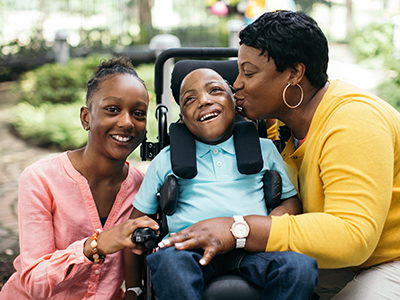 A special issue of the journal Children, guest-edited by Maureen Lyon, Ph.D., clinical health psychologist at Children’s National Hospital, features a compilation of articles from a diverse group of professionals. The authors share their expertise on topics related to psychosocial considerations for children and adolescents living with rare diseases.
A special issue of the journal Children, guest-edited by Maureen Lyon, Ph.D., clinical health psychologist at Children’s National Hospital, features a compilation of articles from a diverse group of professionals. The authors share their expertise on topics related to psychosocial considerations for children and adolescents living with rare diseases.
Co-edited by Lori Wiener, Ph.D., of the National Cancer Institute, the special issue contains articles addressing the psychosocial, neuropsychological and educational needs these children face as well as the impact on their family, friends and community.
According to Lyon and Wiener, “Living with a long-term medical condition, particularly if it is a rare disease, can have a profound impact on the lives of children and their caregivers. Our goal is to update readers on evolving research in the field and familiarize them with useful clinical knowledge and interventions.”
The issue contains 13 peer-reviewed manuscripts from around the globe, including Asia (Taiwan), Australia, Europe (Germany, Italy, Sweden, and Netherlands) and the United States. The following were authored by experts from Children’s National:
- Special Issue: Psychosocial Considerations for Children and Adolescents Living with a Rare Disease. Maureen E. Lyon and Lori Wiener
- Family-Centered Advance Care Planning: What Matters Most for Parents of Children with Rare Diseases. Karen Fratantoni, Jessica Livingston, Sandra E. Schellinger, Samar M. Aoun and Maureen E. Lyon
- “It Is a Whole Different Life from the Life I Used to Live”: Assessing Parents’ Support Needs in Paediatric Palliative Care. Samar M. Aoun, Roswitha Stegman, Renee Deleuil, Suzanne Momber, Lisa Cuddeford, Marianne B. Phillips, Maureen E. Lyon and Fenella J. Gill
- The Transition to Adulthood for Youth Living with Rare Diseases. Melanie Sandquist, TjaMeika Davenport, Jana Monaco and Maureen E. Lyon
Read the full issue of Psychosocial Considerations for Children and Adolescents Living with Rare Diseases.
Marshall Summar, M.D., receives Lifetime Achievement Award for rare disease work
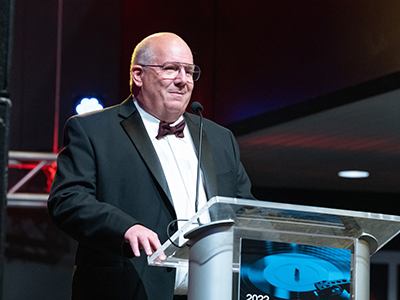
For making strides to improve the lives of the rare disease community, the National Organization for Rare Disorders (NORD®) recognized Marshall Summar, M.D., with a Lifetime Achievement Award.
For making strides to improve the lives of the rare disease community, the National Organization for Rare Disorders (NORD®) recognized Marshall Summar, M.D., chief of the Division of Genetics and Metabolism and the director of the Rare Disease Institute at Children’s National Hospital, with a Lifetime Achievement Award.
This award honors individuals for outstanding career-long achievement on behalf of the rare disease community and commitment to improving the lives of those affected by rare diseases. It has been presented only a few times over NORD’s nearly 40-year history, most recently to former NIH Director Francis Collins, M.D., Ph.D., in 2015 and to clinician and researcher Robert Campbell, M.D., of Children’s Hospital of Philadelphia in 2018.
“I am honored to receive this award from NORD. It is so special to be recognized by the leading rare disease organization. This award comes from the work of so many people over the years, particularly our great team at Children’s National,” said Dr. Summar. “This acknowledgement of what we have done to date just gets me more excited about the future!”
Dr. Summar developed and launched the world’s first Rare Disease Institute at Children’s National in 2017, which is now located on the Children’s National Research & Innovation Campus, a first-of-its-kind pediatric research and innovation hub in Washington, D.C.
The institute, which includes the largest clinical group of pediatric geneticists in the nation, focuses on developing the clinical care field of the more than 8,000 rare diseases currently recognized and advancing the best possible treatments for children with these diseases.
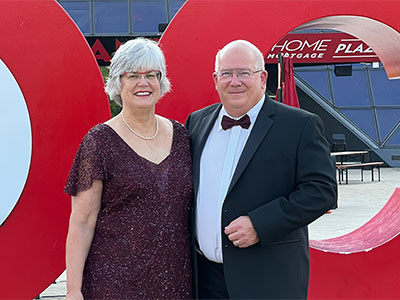
Marshall and Karen Summar.
“Dr. Summar’s passion for serving patients is at the core of everything he does,” said Debra Regier, M.D., medical director of the Rare Disease Institute. “His mentorship for the next generation of medical and biochemical geneticists has become his legacy.”
The work Dr. Summar has done over the course of his career has resulted in new drugs in FDA trials for patients with congenital heart disease and premature birth. He also holds more than 60 patents and has published more than 160 peer-reviewed research studies.
“Beginning with his work as a clinician in the 1980s, Dr. Marshall Summar has spent a career forging partnerships, advocating at the highest level and developing new ways to treat rare disease patients,” said Peter L. Saltonstall, president and CEO of NORD.
“Dr. Summar served on the NORD Board of Directors for nine years, including six years as Chairman, and so we at NORD have been lucky enough to have years of firsthand experience with his leadership, community-building and innovation efforts in the rare disease field. This award is a recognition and appreciation for sustained excellence, including critical work with organizations such as the American College of Medical Genetics, the National Institutes of Health, NORD, and the Rare Disease Institute at Children’s National. For decades of commitment to families and organizations combating rare diseases, NORD is thrilled to present the Lifetime Achievement Award to Dr. Marshall Summar at the 2022 Rare Impact Awards,” Saltonstall added.
Learn more about the Rare Disease Institute at Children’s National.
Increasing the patient’s voice in osteogenesis imperfecta research and care
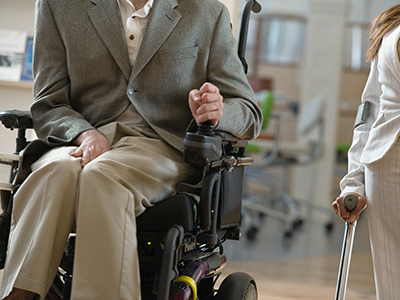
The Osteogenesis Imperfecta Foundation Patient-Centered Outcomes Research Project brought patient voices into efforts to improve patient-centered outcomes research and education in osteogenesis imperfecta.
Rare bone diseases constitute about 5% of all known rare diseases. Osteogenesis imperfecta (OI) is a group of genetic disorders causing connective tissue dysfunction and bone fragility, affecting an estimated 25,000 to 50,000 people in the U.S. Many patients with rare diseases, including those with conditions like OI, suffer from delays in diagnosis and lack of access to the complex multidisciplinary care they require.
Children’s orthopaedic surgeon Laura Tosi, M.D., is the co-lead of a two-year program, Osteogenesis Imperfecta Foundation Patient-Centered Outcomes Research Project. The now completed program brought patient voices into efforts to improve patient-centered outcomes research and education in osteogenesis imperfecta.
Increasingly, the OI community has become more vocal about its need for information and options for evidence-based care. Research about this condition often lacks the patient’s voice. Collecting the patient’s perspective about natural history, clinical best practices, quality of life and research priorities is challenging because, like so many rare diseases, the affected population is relatively small and geographically dispersed.
“We were excited that so many members of the OI community (patients, caregivers, clinicians, and researchers) stepped up to help us with this work for the last two years,” said Dr. Tosi. “They served on committees, completed surveys, and attended training sessions to learn more about patient-centered outcomes research.”
The program accomplished many goals, including creating a community of stakeholders who are trained in patient-centered outcomes research, with specific attention to priority topics identified by the OI community.
“We believe that attention to the broad impact of OI on patients’ lives, from patients’ perspectives, is urgently needed to better inform assessment, care and comparative effectiveness recommendations across the life span,” said Dr. Tosi.
The program considered the patients’ perspective and encouraged a collaborative effort among Children’s National Bone Health Program staff, geneticists, endocrinologists and other specialists to achieve rapid, accurate diagnosis that facilitates individualized care.
“Advances in knowledge can and will happen faster when more people participate in research from the outset,” said Dr. Tosi. “This means not just shaping the questions but also gaining the ability to understand and interpret the impact of such investigations.”
The program also expanded the communications and education strategies related to patient-centered outcomes, even during COVID-19.
The pandemic positively influenced the program’s educational efforts, Dr. Tosi added. The difficulties that emerged in the early months of the pandemic helped capture the community’s attention as they discussed the importance of the program. Through a COVID-19 supplemental award, the program gained more resources to expand the scope of the original education efforts.
With the new challenges and the possible physical and mental health threats that the pandemic posed to people with OI, including isolation and social distancing, the team used engagement strategies to raise awareness of the COVID-19 hazards, disseminated best practices for responses, and enhanced communications between stakeholders. The researchers were able to:
- Expand virtual meetings, which allowed them to reach a wider range of patients.
- Create and disseminate COVID-19 content (e.g., prophylactic care, symptoms, diagnosis, treatment, outcomes).
- Use their existing OI Registry to document and track evolving issues such as more difficult access to medical care (or other necessary services), “daily living” concerns or burdens, and options for safe “return to work” and American Disabilities Act “work accommodations.”
- Gather information on therapeutic options (e.g., pros and cons of medicines, counseling, telemedicine) and their potential to mitigate the health problems that isolation and social distancing create.
- Develop tools to prepare the community for telemedicine, with emphasis on educating health professionals about patients’ higher vulnerability to coronavirus.
While the outcomes of this initiative were overwhelmingly positive, the researchers are also considering some changes, such as implementing “hybrid” models of in-person and remote meetings in the future.
Dr. Tosi served as project co-lead alongside colleagues Tracy Hart, project lead, from the Osteogenesis Imperfecta Foundation (OIF) and Bryce Reeve, Ph.D., co-project lead, director of the Center for Health Measurement at Duke University.
Winners of the first annual Bear Institute PACK Event
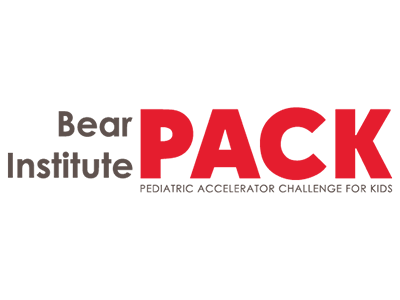
On August 26, 2021, the Bear Institute, along with Children’s National Hospital and Cerner Corporation, hosted the first annual Bear Institute PACK (Pediatric Accelerator Challenge for Kids). Bear Institute PACK is a start-up competition aimed to address the gap in digital health innovation funding dedicated to children.
“Children are a unique population that requires different health solutions than those designed for adults, which address their unique needs,” says Dr. Lu de Souza, Vice President and Chief Medical Officer, Cerner Corporation. “With Bear Institute PACK, we hope to increase focus and delivery of digital health innovations for kids. Bear Institute PACK brings together the pediatric health care community, including pediatric health care providers and hospital administrators from across the country to identify top start-up digital applications that best serve children.”
This year’s start-up participants competed across four innovation tracks, including rare disease, telemedicine, remote patient monitoring and patient education. Student teams competed in a separate student track. Bear Institute PACK consists of three rounds of judging: an initial review of applications from the Bear Institute PACK team, judging from participating pediatric healthcare providers and administrators and review from an expert panel of judges during finalist start-ups’ live pitches.
The start-ups competed for a rich prize pool, including cash prizes totaling over $100,000, on-site pilots and software development support. Winners were selected in each of the event’s four innovation tracks, as well as an additional two student team winners. This year winners are:
- In the rare disease track, first place winner, Bloom Standard, Inc., with its solution Automated Ultrasound Wrap that screen infants and children for serious lung and cardiac conditions, and second place winner, Mira Medical LLC, with its solution Bear Growth: A Three-Dimensional Pediatric Growth Modeling App.
- In the telehealth track, Keriton, Inc., with its solution Keriton Kare, a healthcare SaaS platform built to improve outcomes for neonatal and pediatric patients.
- In the remote patient monitoring track, Sonavi Labs, with its solution Feelix, a platform that features proprietary hardware embedded with clinically validated diagnostic software capable of detecting respiratory diseases.
- In the patient education track, Smileyscope, with its comprehensive virtual reality (VR) platform to help support patients with procedural pain management, drug-free anxiety care, education, and guided relaxation.
- Student team first place winner, CASP Technologies, with its solution Operation Serenity, which allows pediatric patients to prepare for and understand their simulated surgery to reduce anxiety and second place winner, Ankle Rehab, with its solution Foot Joystick for Children with Cerebral Palsy meant to improve mobility.
More information on this year’s winners can be found on the Bear Institute PACK website.
“This year’s Bear Institute PACK had a lot of start-ups and student team participants with very impressive innovation solutions for kids. Selecting a single winner in each innovation track was a tough decision, and it was encouraging to see all the work being done to bring these solutions to market,” says Matt MacVey, Vice President and Chief Information Officer, Children’s National Hospital. “Thank you to everyone who participated and helped make the inaugural Bear Institute PACK a success! We hope to make next year even bigger as we continue to strive to close the gap in funding for children’s digital health innovation.”
More information on next year’s event will be forthcoming on the Bear Institute PACK website.
Commercialization of novel facial analysis technology can improve diagnosis of rare disorders in pediatric patients
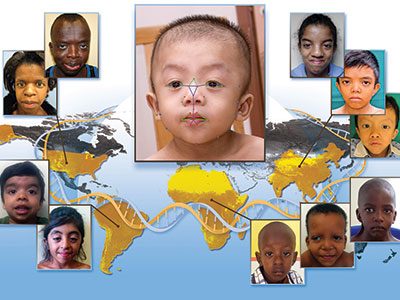
Children’s National Hospital has entered into a licensing agreement with MGeneRx Inc. for its patented pediatric medical device technology using objective digital biometric analysis software for the early and non-invasive screening of dysmorphic genetic diseases such as Noonan syndrome.
Children’s National Hospital has entered into a licensing agreement with life sciences technology company MGeneRx Inc. for its patented pediatric medical device technology using objective digital biometric analysis software for the early and non-invasive screening of dysmorphic genetic diseases. The technology, developed by a multidisciplinary Children’s National team led by Marius George Linguraru, D.Phil, M.A., M.Sc., of the Sheikh Zayed Institute for Pediatric Surgical Innovation and Marshall Summar, M.D., director of the Children’s National Rare Disease Institute (CNRDI), can provide a more advanced diagnostic tool for regions of the world with limited access to geneticists or genetic testing.
The application utilizes artificial intelligence (AI) and machine learning to analyze biometric data and identify facial markers that are indicative of genetic disorders. Physicians can capture biometric data points of a child’s face in real time within the platform, where it scans facial biometric features to determine the potential presence of a genetic disease, which can often be life-threatening without early intervention. Research studies conducted in conjunction with the National Human Genome Research Institute at the National Institutes of Health further enhanced the development of the application in recent years, showing the potential to detect, with a 90 percent accuracy, early diagnosis of 128 genetic diseases across pediatric subjects in 28 countries. These diseases include DiGeorge syndrome (22q11.2 deletion syndrome), Down syndrome, Noonan syndrome and Williams-Beuren syndrome.
“We are delighted to enter into this licensing agreement through Innovation Ventures, the commercialization arm of Children’s National Hospital, which seeks to move inventions and discoveries from Children’s National to the marketplace to benefit the health and well-being of children. Our mission is to add the ‘D’ in development to the ‘R’ in research to accelerate the commercialization of our intellectual property,” says Kolaleh Eskandanian, Ph.D., M.B.A., P.M.P., vice president and chief innovation officer at Children’s National and managing director of Innovation Ventures. “It is through partnerships with startups and the industry that we can achieve this goal and thus we highly value this new partnership with MGeneRx Inc. The acceleration and commercialization of this objective digital biometric analysis technology will not only help diagnose rare genetic disorders – it will also allow for earlier interventions that improve the quality of life for the children living with these conditions.”
Eskandanian adds that the social impact of this technology is especially profound in lower income nations around the world, where there is a high prevalence of rare genetic conditions but a severe lack in the specialty care required to diagnose and treat them. Additional data collected through the expanded use of the technology will help to further develop the application and expand its capabilities to identify and diagnose additional rare genetic conditions.
The licensing agreement was arranged by the Children’s National Office of Innovation Ventures, which is focused on the commercialization of impactful new pediatric medical device technologies and therapies to advance children’s health care. Created to catalyze the ongoing translational research of the Children’s National Research Institute (CNRI) as well as inventions by hospital’s clinicians, Innovation Ventures focuses on four core pillars to advance pediatric medical technologies including a Biodesign program, partnerships and alliances to augment internal capacity, seed funding to de-risk technologies and validate market and clinical relevance, and back-office operations to manage intellectual property and licensing activities. Since 2017, Children’s National intellectual property has served as the basis for over 15 licensing or option agreements with commercial partners.
Providing access to an array of experts and resources for pediatric innovators is one of the aims of the Children’s National Research & Innovation Campus, a first-of-its-kind focused on pediatric health care innovation, with the first phase currently open on the former Walter Reed Army Medical Center campus in Washington, D.C. With its proximity to federal research institutions and agencies, universities, academic research centers, as well as on-site incubator Johnson and Johnson Innovation – JLABS, the campus provides a rich ecosystem of public and private partners, which will help bolster pediatric innovation and commercialization.
Genetic disorders, including osteogenesis imperfecta, rarely mimic child abuse

In suspected child abuse cases, pediatric specialists are often called for clinical consultations or subpoenaed to courtrooms to discuss unexplained fractures and hemorrhage. During routine clinical practice, Children’s National Hospital (CNH) geneticists, child abuse pediatricians, orthopedists and radiologists use a multidisciplinary, stepwise approach that differentiates genetic disorders from cases of suspected child abuse. These teams provide a clear process for when clinical and radiological review suffices versus cases when judicious use of genetic testing and biochemical testing should be considered.
Every year, approximately 675,000 children suffer abuse or neglect, and at least 1,700 die from abuse — one of the leading causes of childhood morbidity and mortality nationwide.
Ill-intended arguments regarding genetic disorders often reach the court. Out of the 7,000 known rare diseases, rare bone diseases constitute about 5% of the cases. When there are true genetic disorders like osteogenesis imperfecta (OI), a group of genetic disorders that cause fractures, orthopedic specialists help tremendously with diagnosis and treatment. The Children’s National Bone Health Program specializes in caring for healthy children, children with genetic bone conditions, and children whose bones have been damaged from illness or poor nutrition. Their team of experts enhances treatment to meet the needs of each child help us provide the best possible care for children with a broad range of bone health conditions When a rare condition that causes bone fragility is suspected, these teams work together to provide proper diagnosis and management.
“OI is a diagnosis that can be made clinically with the help of geneticists, radiologists and orthopedists,” said Tanya Hinds, M.D., a child abuse pediatrician at Children’s National. “Outside of the newborn period, multiple unexplained fractures in infants with radiologically normal bones is suspicious for child physical abuse, not OI.”
When these regional cases reach the courtroom, Children’s National pediatricians often serve as clinician-educators and expert witnesses. According to Children’s National experts, clinicians must share the best available medical practices in both the hospital and courtroom. Unfortunately, in some cases around the country, a handful of expert medical witnesses provide unique and unsubstantiated opinions, sometimes claiming the presence of a rare genetic disorder as a cause of fracture or hemorrhage, when this has not been diagnosed by mainstream genetics specialists.
“On the part of expert witnesses, scientifically sound explanations versus unfounded hypotheses can influence outcomes in civil proceedings, which determine a child’s placement and criminal proceedings, which determine judgment on the perpetrators,” said Natasha Shur, M.D., medical geneticist at Children’s National, and Nathaniel Robin, M.D., professor and clinical genetics director at the University of Alabama in an editorial published in Current Opinion in Pediatrics.
Dr. Hinds works on behalf of children to provide the best and most comprehensive work-up in cases of unexplained fractures or hemorrhage. As a board-certified child abuse pediatrician, she is responsible for implementing the evidence-based practice guidelines of the American Academy of Pediatrics and other similar societies. Dr. Hinds mentioned that it is possible to use medical history, physical examination and diagnostic testing to differentiate traumatic causes of fractures and subdural hematomas from genetic causes, a belief she states is held by the vast majority of child serving clinicians.
“In cases of suspected child abuse, a multidisciplinary group of clinicians at Children’s National routinely provide comprehensive and top-rate care and consider alternative explanations for fractures,” said Eglal Shalaby-Rana, M.D., a radiologist at Children’s National who has partnered with the hospital’s Child and Adolescent Protection Center team on these challenging cases since 1991. “A multidisciplinary team is crucial to the evaluation and often includes additional specialists such as pediatric radiology, trauma surgery, hematology and in some cases genetics.”
Further, these clinician-educators and researchers at Children’s National call for increased publication and use of consensus guidelines such as the consensus statement on abusive head trauma published in Pediatric Radiology in 2018. “Consensus guidelines synthesize the best available medical evidence and should be the basis for both clinical practice and education offered in the courtroom,” said Drs. Shur, Hinds and Shalaby-Rana.
Distinguishing child abuse from genetic disorders
Drs. Hinds, Shalaby-Rana and Shur have served as expert witnesses and in turn wanted to come together to help develop frameworks that share scientifically sound information with peers who might encounter spurious arguments in courtrooms regarding genetic disorders as an explanation for physical abuse and inflicted fractures. Their 2021 literature review, published in Current Opinion in Pediatrics, addresses some of these issues.
To help distinguish child physical abuse from a genetic disorder, Drs. Shur, Hinds and Shalaby-Rana worked as a multidisciplinary team to highlight best practices in six instances when genetic disorders were raised as explanations for inflicted fractures or hemorrhage, including Elhers-Danlos syndrome (EDS), osteogenesis imperfecta (OI), Menkes Disease and Glutaric Acidemia type I. In some cases, these explanations could be reasonable but should be diagnosed using routine clinical and radiological review, and when indicated, genetic and biochemical testing.
For instance, EDS is a diagnosis that is sometimes erroneously used to explain multiple fractures in cases of suspected physical abuse and can be misused in courtrooms. The most common EDS type is hypermobile EDS, often found in late adolescence or early adulthood. In some cases, babies erroneously receive hypermobility exams, or clinicians perform hypermobility assessments on parents of children with unexplained fractures — neither practice is indicated. Instead, the Children’s National team points out that children should receive a medical evaluation using the standard guidelines set by the American Academic of Pediatrics, American College of Radiology and other professional societies.
Dr. Shur also collaborated with radiologists at Boston Children’s Hospital in a related review published in Pediatric Radiology. There, George et al. addressed the clinical and molecular diagnosis criteria for EDS to help radiologists prevent misdiagnosis and support clinicians when seeing patients with multiple fractures.
“It is disturbing that the unsubstantiated EDS infant bone fragility hypothesis continues to be advanced in civil and criminal child abuse proceedings when fractures are not part of the diagnosis criteria for EDS,” said George et al.
The clinicians noted that the Beighton score, which helps diagnose hypermobile EDS, is not intended for children younger than 8 years old. Additionally, since the score provides insufficient data, other EDS features must be present, such as skin findings and connective tissue abnormalities.
OI, known as ‘‘brittle bone disease,’’ is a group of disorders that rarely present only with unexplained fractures. The researchers emphasize that infants and children with mild OI do not present exclusively with multiple fractures, which are specific to physical abuse such as multiple, bilateral rib fractures and classic metaphyseal lesions. Drs. Shur, Hinds and Shalaby-Rana share that pediatric specialists could overcome the diagnostic challenges between OI and child abuse through the inclusion of a genetic team in some cases, during the medical evaluation while also considering various criteria, such as family history, physical examination and laboratory findings. Molecular testing may be required in some instances, but it cannot substitute traditional clinical and radiology evaluations, according to these clinician-researchers.
Similarly, while Menkes disease can present with intracranial hemorrhage and fractures like child physical abuse, there are other distinguishing characteristics unique to Menkes disease, such as hair and facial dysmorphism. In a third related case-review published in Pediatric Radiology, Shur, Hinds and Shalaby-Rana et al. emphasize that diagnostic difficulties may arises when a multidisciplinary evaluation is omitted. They call upon all clinicians to provide ethical testimony in civil or criminal proceedings and to continue to utilize a multidisciplinary approach during daily clinical practice.
Irresponsible testimony and predatory journals
According to George et al., in collaboration with Dr. Shur, there are flawed publications on EDS associated with infant bone fragility that do not follow the gold standard of the scientific community. They believe this hypothesis must be rejected by experts in the field of pediatric imaging to safeguard the scientific integrity of the discipline. The lack of scientific design, peer review process and transparency causes negative consequences in the courtroom and threatens the proper adjudication of cases of suspected child physical abuse.
“Irresponsible testimony increasingly enters medico-legal proceedings dealing with allegations of child abuse, and so-called expert witnesses regularly cite these deeply flawed publications — in addition to misquoting the medical literature, loosely interpreting medical findings, presenting fictitious findings, and excluding salient and widely accepted facts from consideration,” said George et al.
In these pieces of literature, our Children’s National multidisciplinary team members reviewed the best available evidence and their collective decades of patient experience to highlight standard processes, which differentiate child physical abuse as a cause of fractures and hemorrhage from rare disorders. Rare does not mean mysterious, and with education and a multidisciplinary approach, every child can receive the best possible medical work-up and care, according to Drs. Shur, Hinds and Shalaby-Rana. They urge all physicians to share only mainstream clinical medicine in the courtroom to help ensure the best possible social outcomes for children and their families.
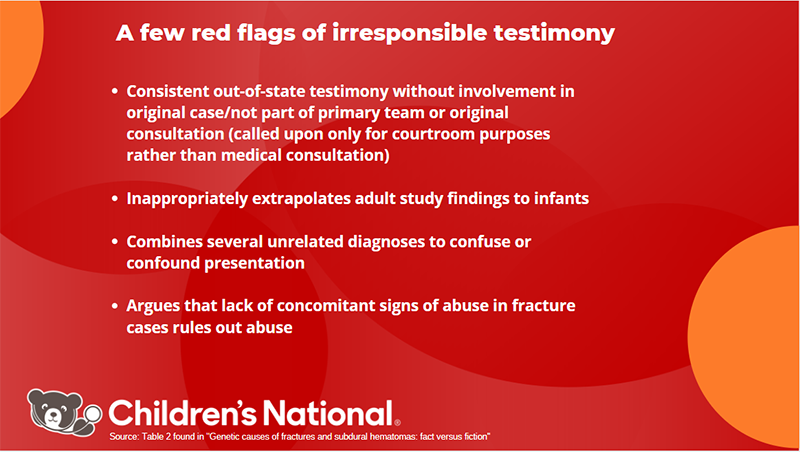
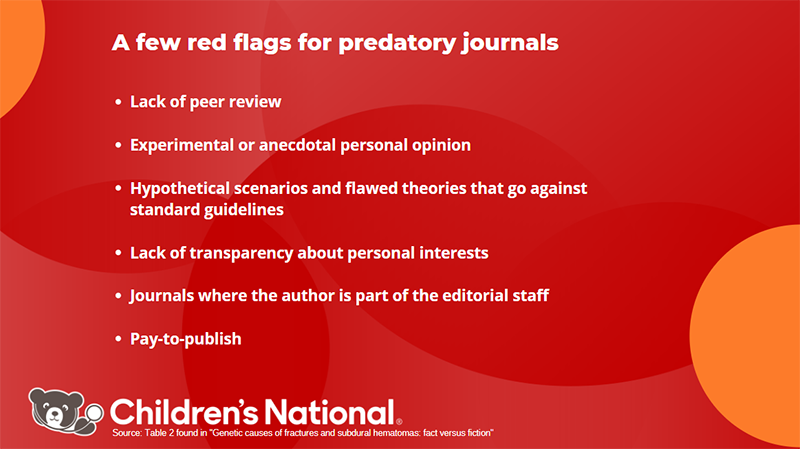
Pediatric Research names Andrea Hahn, M.D., M.S., early career investigator
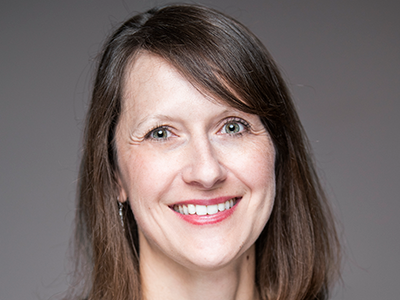
“I am honored to be recognized by Pediatric Research and the Society of Pediatric Research (SPR) at large,” said Dr. Hahn. “SPR is an amazing organization filled with excellent scientists, and to be highlighted by them for my work is truly affirming.”
For her work on the impact of bacterial functional and metabolic activity on acute episodes of cystic fibrosis, the journal Pediatric Research recognized Andrea Hahn, M.D., M.S., as Pediatric Research’s Early Career Investigator.
Cystic fibrosis is an autosomal recessive genetic disease, affecting more than 70,000 people worldwide. The condition’s morbidity and mortality are recurrent and result in a progressive decline of lung function.
“I am honored to be recognized by Pediatric Research and the Society of Pediatric Research (SPR) at large,” said Dr. Hahn. “SPR is an amazing organization filled with excellent scientists, and to be highlighted by them for my work is truly affirming.”
The exact mechanisms of the bacteria that chronically infect the airway triggering acute cystic fibrosis episodes, also known as pulmonary exacerbations, remain unclear. Dr. Hahn’s research is one of the few to explore this gap and found an association with long-chain fatty acid production in cystic fibrosis inflammation.
“As a physician-scientist, there are many competing priorities between developing and executing good science — including writing manuscripts and grants — and providing excellent patient care both directly and through hospital-wide quality improvement initiatives,” said Dr. Hahn. “It is often easier to have successes and feel both effective and appreciated on the clinical side. This recognition of my scientific contributions to the medical community is motivating me to continue pushing forward despite the setbacks that often come up on the research side.”
The exposure to many programs and institutions gave Dr. Hahn the foundation to create a research program at Children’s National that helps decipher the complexities of antibiotic treatment and how it changes the airway microbiome of people with cystic fibrosis. The program also explores the impacts of antibiotic resistance and beta-lactam pharmacokinetics/pharmacodynamics (PK/PD) — the oldest class of antibiotics used to treat infections.
Dr. Hahn believes that the people and environment at Children’s National Hospital allowed her to grow and thrive as a physician-scientist.
“I was initially funded through an internal K12 mechanism, which was followed up by Foundation support, which was only possible because of the strong mentorship teams I have been able to build here at Children’s National,” said Dr. Hahn. “My division chief has also been very supportive, providing me with both protected time as well as additional resources to build my research lab.”
She is particularly appreciative of Robert Freishtat, M.D., M.P.H, senior investigator at the Center for Genetic Medicine Research, and Mary Callaghan Rose (1943-2016).
“Robert Freishtat has been a great advocate for me, and I am indebted to him for my success thus far in my career,” said Dr. Hahn. “Likewise, I want to specifically recognize Mary Rose. She was a great scientist at Children’s National until her death in 2016. She gave me the initial opportunity and support to begin a career studying cystic fibrosis, and she is missed dearly.”
You can learn more about Dr. Hahn’s research in this Pediatric Research article.
NORD names Natasha Shur, M.D., as hero of rare disease
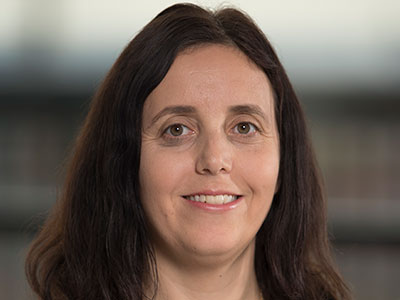
Dr. Shur has a career working as a clinical geneticist for over a decade. She has been a part of the Children’s National community for more than two years. Dr. Shur as well serves as the lead for the Telemedicine Genetics Program under the Rare Disease Institute.
For her advancements in telemedicine genetics and rare diseases, Medical Geneticist Natasha Shur, M.D., received the 2021 Rare Impact Award from the National Organization for Rare Disorders (NORD). The recognition is the highest honor given to individuals that developed exceptional work benefiting the rare disease community.
“Despite the pandemic and the challenges we have faced, there are still heroes to be found among us from whom we can draw inspiration and motivation to keep moving forward,” said Peter L. Saltonstall, NORD president and CEO.
Given her involvement with several innovative projects at Children’s National Hospital, Dr. Shur built an active in-home telemedicine program where patients are being seen for first visits and follow-ups. Her work is helping families, including those with autistic children.
“Recently, in our division, we have been talking a lot about the concept of ‘failing forward.’ The idea is to try new approaches. These methods may not work, but the status quo does not always work either,” said Dr. Shur. “Since we have such a supportive and wonderful group, we can try new ways of working and new models of care.”
During the pandemic, the division led by Marshall Summar,.M.D., also created a telehealth first model of care and augmented educational apps and opportunities. The goal was to ensure that patients with rare disease would not lose access to care. The medical geneticists, genetic counselors, dieticians and administrative team met daily and cohesively to explore and improve new clinical approaches in order to put patients and families first.
Dr. Shur has a career working as a clinical geneticist for over a decade. She has been a part of the Children’s National community for more than two years. Dr. Shur as well serves as the lead for the Telemedicine Genetics Program under the Rare Disease Institute.
The Rare Disease Institute recently opened its new location on the Children’s National Research & Innovation Campus, a first-of-its-kind pediatric research and innovation hub located in Washington, D.C. The campus will provide a unique, state-of-the-art home for clinical genetic and specialty services.
Raising awareness about Turner Syndrome
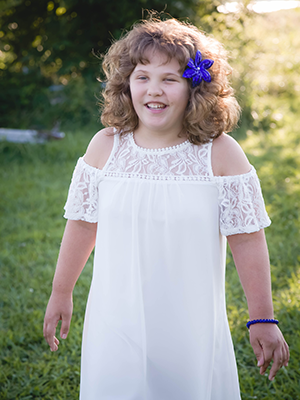
Gracie Popielarcheck was diagnosed at age one with Turner Syndrome.
By Roopa Kanakatti Shankar, M.D., M.S., Director of the Turner Syndrome Program at Children’s National Hospital.
The Children’s National Turner Syndrome Clinic is part of the Division of Endocrinology and Diabetes which is ranked by U.S. News & World Report as one of the top 10 programs in the nation. The clinic opened in January 2019 and is the first of its kind in the Washington, D.C., region. A multidisciplinary clinic is held once a month with a team experts in cardiology, endocrinology, psychology, gynecology and genetics to help care for the needs of patients with Turner Syndrome all in one day. The referral network of specialties includes neuropsychology, otolaryngology, audiology, orthopedics, urology and dentistry.
Turner syndrome (TS) is a rare disease affecting girls, with a prevalence of around 25-50 out of every 100,000 females. It is caused by partial or complete loss of the second sex chromosome. This affects multiple organs and can cause heart defects, skeletal abnormalities, hearing loss and learning difficulties. It also affects growth and puberty and can cause infertility. Although the condition was first described in 1938 by Henry Turner, an endocrinologist from Oklahoma, and is well characterized, there is a significant delay in diagnosis and recognition of the condition, especially in milder forms that can still significantly impact the well-being of the individual.
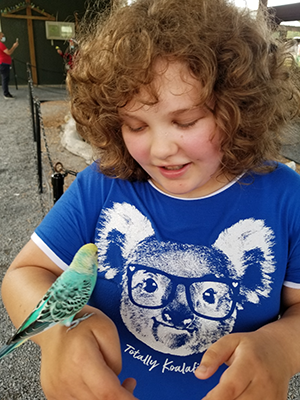
“Having a Turner Syndrome clinic near our city has made life so much easier,” says Gracie’s mom, Leslie Popielarcheck. “We can see all of Gracie’s specialists all in one day and under one roof.”
Families often ask why it took so long to recognize this condition. Many findings can be subtle, the presentation can vary greatly and often short stature may be overlooked in some girls. We now recognize that the classic form (monosomy X) impacts less than half of the girls and the rest have mosaicism (45,X/ 46XX) or other structural abnormalities in the X-chromosome. Recognizing features beyond the classic “short stature, neck webbing, lymphedema and cardiac defects” is indeed important to get timely care for these girls and women across the lifespan. Many have recurrent ear infections and hearing loss. Most have a normal intelligence, and even superior verbal skills but face challenges in visual spatial perception, executive function, working memory and social cognition that impact academic achievement.
13-year-old Gracie Popielarcheck was diagnosed with TS at the age of one after her parents noticed a delay in her speech and development. “We had never heard of Turner Syndrome when Gracie was diagnosed,” says Leslie Popielarcheck, Gracie’s mom. “Gracie didn’t have the classic physical features that girls with Turner Syndrome are known to have.”
With support, most of these girls and women can manage the medical and psychosocial challenges and rise to their full potential. Advances in the field and multidisciplinary care models have helped in the establishment of TS clinics across the country that strive to improve the standard care for these girls.
However, several challenges remain:
- Improving awareness among primary care physicians in regard to the extended spectrum and variability of presentation at a wide variety of ages
- Decreasing health disparities and making multidisciplinary clinics and comprehensive care available and accessible even to disadvantaged communities
- Ensuring adequate medical and social support for transition of young adults and care of adults with Turner syndrome
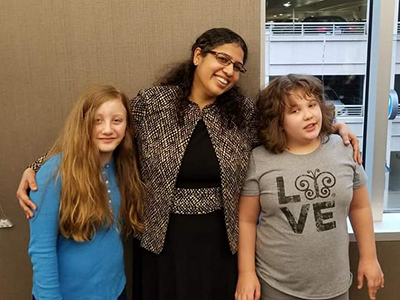
Kyra Dorfman, Dr. Shankar and Gracie.
Our TS program, initiated 2 years ago, aims to overcome these challenges and provide care to families impacted by TS in our community. We strive to serve as a Regional Resource for the community as well as physicians in our community and have been recognized by the TSGA (Turner syndrome Global Alliance) as one of only nine clinics nationwide with a Level 4 designation.
“Having a Turner Syndrome clinic near our city has made life so much easier,” Popielarcheck says. “We can see all of Gracie’s specialists all in one day and under one roof.”
As we highlight these resources for the Turner Syndrome Awareness Month this February 2021, and celebrate the strength and tenacity of our beautiful girls, we hope our efforts will improve recognition of the condition and delivery of comprehensive medical care and support to the community we serve.
Children’s National Research Institute receives NIH grant for palliative care study
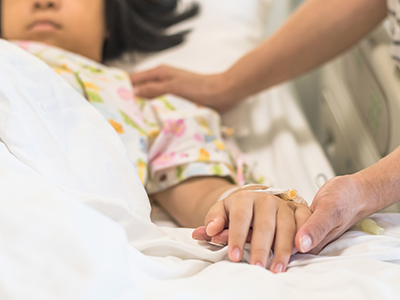
A new NIH grant will support the first study that examines palliative care needs in pediatric rare disease community.
The National Institute of Health (NIH) has awarded $500,875 to the Children’s National Research Institute (CNRI), the academic arm of Children’s National Hospital, to support a new study examining the palliative care needs of children living with rare genetic diseases.
This is the first study of families of children with genetic and metabolic conditions, termed collectively as rare diseases, that is designed to intervene to support the well-being of family caregivers and create advance care plans for future medical decision making. In the United States, a rare disease is defined as a particular condition affecting fewer than 200,000 people. Pediatric patients with rare diseases experience high mortality rates, with 30 percent not living to see their fifth birthday.
“Children with ultra-rare or complex rare disorders are routinely excluded from research studies because of their conditions, creating a significant health disparity. Surveys show that families of children with rare diseases are adversely impacted by lack of easy access to peer and psychological support,” says Maureen Lyon, Ph.D., Clinical Health Psychologist and Professor of Pediatrics at the CNRI and principal investigator on the project. “This study will examine the palliative care needs of family caregivers of children with rare genetic disorders and advance care planning intervention, which will ultimately help facilitate discussions about future medical care choices that families are likely to be asked to make for their child.”
Although greatly needed, there are few empirically validated interventions to address these issues Currently, there is only one intervention described for families of children with rare diseases — a Swedish residential, competence program — which focuses on active coping. However, this intervention does not address pediatric advance care planning, a critical aspect of palliative care.
Lyon adds that the major benefit of this proposed project will be filling the gap in knowledge about what family caregivers of medically fragile children with rare diseases want with respect to palliative care. In the United States, these families are expected to provide a level of care that, until a few decades ago, was reserved for hospitals.
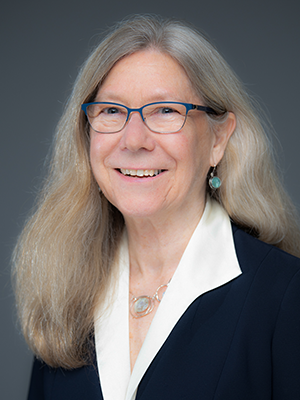
Maureen Lyon, Ph.D., Clinical Health Psychologist and Professor of Pediatrics at the CNRI and principal investigator on the project.
“Our hope is that this study will provide a structured model for facilitating family decisions about end-of-life care, for those families who do not have the good fortune to have children who have the capacity to share in decision-making,” Lyon says.
In addition to bridging the knowledge gap regarding palliative care in rare disease patients, the study will also help inform current clinical, ethical and policy discussions, as well as the legal issues in a variety of areas, such as the debate surrounding advocacy, particularly for those children with impairments in physical function.
“We look forward to the results of this study,” said Marshall Summar, M.D., director of the Rare Disease Institute and division chief, Genetics and Metabolism at Children’s National Hospital. “As a leader in rare disease care, we continually examine how we can improve care and support for our patient families at our clinic and want to share our findings with others engaged in caring for rare disease patients. Because rare diseases can be life limiting in some cases, we need to learn all we can about how best to care and support a patient and family as they prepare for a potential transition to palliative care.”
All research at Children’s National Hospital is conducted through the CNRI, including translational, clinical and community studies. The CNRI also oversees the educational activities and academic affairs of the hospital and the Department of Pediatrics at the George Washington University School of Medicine and Health Sciences, frequently partnering with many other research institutions regionally and nationally. CNRI conducts and promotes translational and clinical medical research and education programs within Children’s National Hospital that lead to improved understanding, prevention, treatment and care of childhood diseases.
Technology bridges knowledge gaps in rare bone disease care
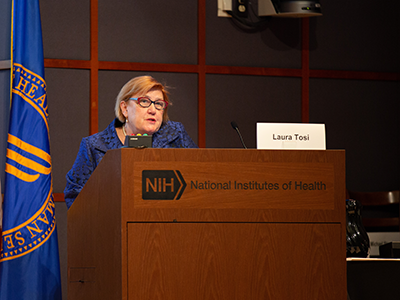
Dr. Tosi and colleagues presented on the NIH Rare Disease Day 2020 panel, Nontraditional Approaches to Improving Access for Rare Diseases.
As part of the global observance of Rare Disease Day in February, the NCATS and NIH Clinical Center hosted a special event to raise awareness about rare diseases, the people they affect and NIH research collaborations under way to address scientific challenges and advance new treatments.
This year, Children’s National Hospital orthopaedic surgeon Laura Tosi, M.D., took part in an afternoon panel, Nontraditional Approaches to Improving Access for Rare Diseases, where she outlined her work as the faculty chair of the Rare Bone Disease TeleECHO, a virtual meeting that allows care providers and experts to come together via the Zoom platform, discuss diagnosis of specific disorders and present cases for group input.
Dr. Tosi and the Rare Bone Disease Alliance have called Project ECHO Rare Bone Disease a game changer for care of these complex conditions. Rare bone disorders are only about 5% of all birth defects but include 461 skeletal disorders caused by 437 genes – making it difficult for any physician to see enough cases of any one disorder to correctly diagnose and treat it.
“Most doctors are like me, a pediatric orthopaedic surgeon. I need to know a lot of different rare diseases and it’s hard to keep everybody on the cutting edge,” Dr. Tosi says. “Even though we have found the genes for most of the disorders, the phenotypic overlaps, shortage of specialists and the multi-disciplinary needs of so many of the patients add to the challenges.”
So 7 months ago, Dr. Tosi joined together with colleagues at the Rare Bone Disease Alliance and the Osteogenesis Imperfecta Foundation to launch Project ECHO Rare Bone Disease. The now monthly telehealth meeting engages a distinguished faculty of experts from around the world and from across the spectrum of care for these rare bone disorders, including specialists in genetics, endocrinology, orthopaedics and others.
Project ECHO is a specific model for bridging distance and creating a network of professionals, with the goal of leveling the playing field for all by making vital information accessible to everyone, regardless of their location. In healthcare the model transcends traditional “telemedicine,” however. The program, launched from the University of New Mexico, self-describes itself as “telementoring, a guided practice where the participating clinician retains responsibility for the patient” but is able to discuss diagnosis and therapeutic recommendations with a set of esteemed faculty via a regular virtual meeting series.
In the case of the Rare Bone Disease TeleECHO, the ECHO’s faculty decided on two major foci for the curriculum. Half of the content is about how to make the right diagnosis and the other half shares the latest information about specific diseases. The sessions also offer free CME to attendees.
Dr. Tosi says that while finding cases to discuss can sometimes be challenging when it comes to rare bone diseases, she takes responsibility on herself to make sure the content is robust each month. So far the meetings have attracted between 40 and 90 participants per session – a great engagement rate for such a young teleECHO program.
“I believe ECHO advances knowledge of healthcare and democratizes it by offering universal accessibility across the globe,” Tosi notes.
The Rare Bone Disease Alliance, which consists of 12 organizations, experts and patient families working together, is now deciding what’s next for the Rare Bone Disease TeleECHO. They may develop disorder-specific ECHOs, are studying the frequency of the sessions and how best to improve participation for all sessions. The idea is to increase access to this expertise even further, as it could have critical impacts on patients worldwide living with these rare diseases.
In terms of key take-aways from the panel of experts at Rare Disease Day, the hope is that more disease groups might leverage this type of technology to connect people in nontraditional ways. Doing so has the potential to ensure that everyone with a rare disease receives the best support and care possible because their doctors have the knowledge they need when they need it.
Watch more sessions from the NIH’s Rare Disease Day 2020.


